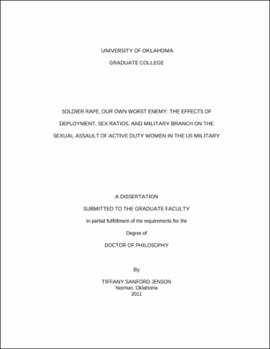| dc.description.abstract | Since 1988, the Department of Defense (DoD) has conducted wide-scale surveys about the sexual assault experiences of active-duty military members. Despite the growing body of research on this topic and widespread gender integration efforts for female soldiers, scholars still lack an understanding of rape occurring in the military, especially how conditions of deployment, military branch, and sex ratios relate to this issue. For example, in the recent military campaigns in Iraq and Afghanistan, what effect does deployment have upon the likelihood of becoming a sexual assault victim for women? Do deployment conditions affect the likelihood of rape or does it have more to do with the organization of men and women within the work unit or the culture of the military branch? "Cultures of rape" or behaviors that allow for sexual assault to occur and/or go unresolved are prevalent within heavily male institutions such as the military. This study uses the 2006 Workplace and Gender Relations Survey of Active Duty Members to examine the relationship between sexual assault, deployment, sex ratios, and military. Findings suggest that female members of the Army, Marines, and Navy are significantly more likely to be sexually assaulted compared to those within the Air Force but the effect of branch diminishes when deployment and sex ratios are taken into account. The most consistent factors for predicting victimization for female service members is membership in the Army and being currently deployed. While the sex ratios of women's workgroups (consisting of all or mostly males, being the token female in the unit, etc.) do account for the increased likelihood of rape, these sex ratios do not explain why currently deployed women have increased risks of rape. Further, it appears that the "culture of rape" exists within certain military branches such as the Army and not in others (Air Force). Deployment generally (those currently or previously deployed) increased the likelihood of rape victimization for women with being currently deployed as the more significant predictor. Overall, being a member of the Army, despite the deployment status or sex ratios of the workgroup, greatly increased the odds of experiencing sexual assault. This may be evidence of differing opportunity structures for victimization inherent in the Army as compared to the other military branches. | |
